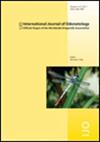A tale of two Skimmers: complex relationships between DNA barcodes, distributions and taxonomy in European Orthetrum cancellatum and O. coerulescens
IF 1
4区 农林科学
Q3 ENTOMOLOGY
引用次数: 1
Abstract
We explore the genetic diversity and phylogeography of the dragonflies Orthetrum cancellatum and O. coerulescens in Europe based on mitochondrial and nuclear DNA. Orthetrum cancellatum has a clear division between a group comprising Maltese, Italian, and central and northern European populations, and a group comprising mainly populations from southwestern and southeastern Europe, as well as some northern European specimens. We propose that the two groups represent two different Glacial refugia, one in the Italian Peninsula and one in the Balkans where the species survived during the Weichsel Glaciation. Orthetrum coerulescens shows a more complex pattern, although it too can be divided into two groups. One group comprise all the specimens we have identified as O. coerulescens anceps from their phenotype as well as specimens from Spain, Montenegro, and Pakistan, and some specimens from Italiy, Poland and Bulgaria. The other group comprise all other specimens from central and northern Europe, almost all specimens from Italy and Bulgaria, and all specimens from Malta. We propose that the latter group represents an Italian Glacial refugium from which the species spread to both central Europe, Malta and southern Balkan (Bulgaria) after the end of the Weichsel Glaciation. As specimens from Spain and Bulgaria, which were identified as O. coerulescens coerulescens group with specimens identified as O. coerulescens anceps we conclude that the two subspecies mix more or less freely across the Mediterranean and question the validity of two subspecies.两个撇脂者的故事:DNA条形码、分布和分类之间的复杂关系
基于线粒体和细胞核DNA,我们探索了欧洲松质蜻蜓和柯氏蜻蜓的遗传多样性和系统地理学。松质Orthetrum cancellatum在一个由马耳他、意大利、中欧和北欧种群组成的群体和一个主要由西南欧和东南欧种群以及一些北欧标本组成的群体之间有着明确的划分。我们认为,这两个群体代表了两个不同的冰川避难所,一个在意大利半岛,另一个在巴尔干半岛,该物种在魏克塞尔冰川作用期间幸存下来。Orthetrum共规则中心表现出更复杂的模式,尽管它也可以分为两组。其中一组包括我们从表型上确定为共规则杆线虫祖先的所有标本,以及来自西班牙、黑山和巴基斯坦的标本,以及一些来自意大利、波兰和保加利亚的标本。另一组包括来自中欧和北欧的所有其他标本,几乎所有来自意大利和保加利亚的标本,以及所有来自马耳他的标本。我们认为后一组代表了一个意大利冰川避难所,在魏克塞尔冰川期结束后,该物种从该避难所传播到中欧、马耳他和巴尔干半岛南部(保加利亚)。作为来自西班牙和保加利亚的标本,这些标本被鉴定为O.coerulescens coerulessens群和O.coerrulescens祖先,我们得出结论,这两个亚种或多或少在地中海自由混合,并质疑两个亚种的有效性。
本文章由计算机程序翻译,如有差异,请以英文原文为准。
求助全文
约1分钟内获得全文
求助全文
来源期刊

International Journal of Odonatology
ENTOMOLOGY-
CiteScore
2.30
自引率
0.00%
发文量
15
审稿时长
>12 weeks
期刊介绍:
International Journal of Odonatology (IJO) is aimed at providing a publication outlet for the growing number of students of Odonata. It will address subjects such as the ecology, ethology, physiology, genetics, taxonomy, phylogeny and geographic distribution of species. Reviews will be by invitation, but authors who plan to write a review on a subject of interest to the journal are encouraged to contact the editor.
 求助内容:
求助内容: 应助结果提醒方式:
应助结果提醒方式:


